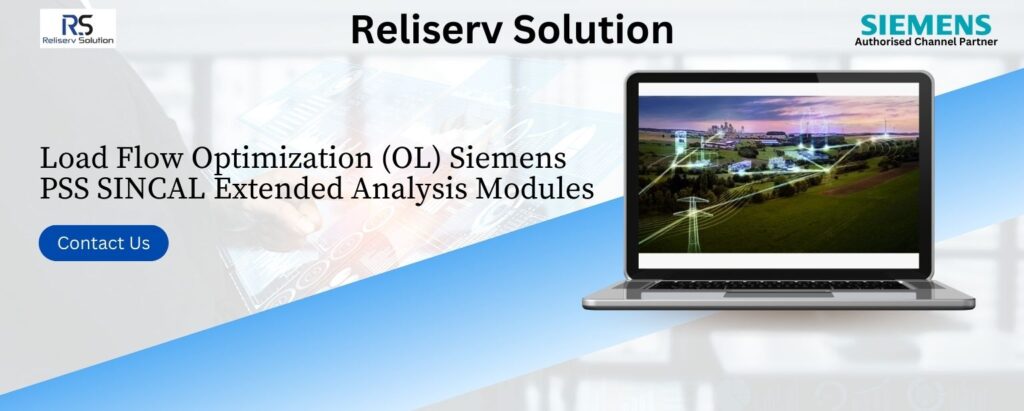For Enquiries: +91-7506112097 / +91-9137486428
Streamlining Grid Operations: Exploring Load Flow Optimization Techniques with Siemens PSS SINCAL Extended Analysis Modules
In the ever-evolving landscape of power distribution and grid management, optimizing Load Flow Optimization (OL) stands as a critical aspect for ensuring efficiency and stability. The advent of innovative technologies, such as Siemens PSS SINCAL Extended Analysis Modules, introduces a new paradigm in grid operations. This blog aims to delve into the intricate realm of load flow optimization techniques facilitated by these modules, offered by Siemens. The introduction of these advanced analysis modules signifies a pivotal shift towards enhancing grid performance, enabling utilities and operators to streamline operations, manage power flow effectively, and mitigate potential grid issues. Through a detailed exploration of the functionalities and capabilities embedded within the PSS SINCAL Extended Analysis Modules, we aim to uncover how these technologies revolutionize grid management, fostering a more reliable and resilient power infrastructure.
Siemens’ PSS SINCAL Extended Analysis Modules play a pivotal role in revolutionizing the landscape of grid operations by offering sophisticated techniques for load flow optimization. This introduction marks the beginning of an insightful journey into understanding the complexities of power distribution, where the focus lies on leveraging these cutting-edge modules to address contemporary challenges. By honing in on load flow optimization techniques, this blog will explore how Siemens’ innovative solutions empower utilities, engineers, and operators to achieve enhanced grid stability, optimized power transmission, and more efficient energy management. Through this exploration, we aim to unravel the transformative impact of PSS SINCAL Extended Analysis Modules in reshaping the dynamics of grid operations for a more sustainable and reliable energy future.
Brief Overview of Modern Grid Operations Challenges
In today’s rapidly evolving energy landscape, grid operators face multifaceted challenges. Factors such as increased demand, integration of renewable energy sources, ageing infrastructure, and the need for enhanced reliability pose significant challenges to grid management. Additionally, the bid for grid modernization requires efficient tools and methodologies to optimize power flow within the network.
Introduction to Load Flow Optimization (OL)
Load Flow Optimization is a pivotal aspect of grid management. It refers to the process of analyzing, controlling, and optimizing the flow of electrical power through a network. It ensures that power generation matches the demand, minimizes losses, maintains voltage levels within limits, and enhances the overall grid performance. Load Flow Optimization is essential to maintain grid stability and efficiency.
The PSS SINCAL Load Flow Optimization (OL) module serves to assess and improve network structures and loads. It proves valuable in both network operation maintenance and planning. This method involves adjusting network variables within predefined limits to minimize active power losses. This capability empowers users to analyze networks thoroughly and devise variations for cost-effective network planning.
This module identifies network conditions aiming to minimize transmission losses and limit technical violations. By doing so, it diminishes voltage fluctuations at network nodes.
System variables manipulated include generator voltages, generator reactive powers, and transformer transformation ratios. The module considers observed limits such as equipment loading, voltage ranges, and the allowable P/Q diagram for generators.

Understanding Siemens PSS SINCAL Extended Analysis Module
- Definition and Purpose of Load Flow Optimization in Power Systems
Load Flow Optimization within power systems refers to the systematic analysis and adjustment of various electrical parameters to ensure an efficient and balanced distribution of electrical power. Its primary purpose is to manage and optimize the flow of electricity within the network, minimizing losses and maintaining stable voltage levels. It aims to enhance the overall performance and reliability of the power grid by ensuring that generation matches demand while minimizing inefficiencies.
- Significance in Enhancing Grid Efficiency and Reliability
Load Flow Optimization plays a pivotal role in enhancing grid efficiency and reliability. By effectively managing power flow, it reduces losses, improves voltage stability, and ensures optimal utilization of resources. This optimization technique helps prevent the overloading of transmission lines, mitigates voltage deviations, and enhances the grid’s ability to handle varying loads and contingencies. Ultimately, it contributes to a more robust and reliable power system.
- Key Factors Influencing Load Flow and Grid Performance
Several critical factors influence load flow and grid performance. These include the demand-supply balance, network topology, impedance characteristics of transmission lines, transformer configurations, reactive power management, and system protection. Additionally, the integration of renewable energy sources, varying consumer demands, and dynamic changes in power generation patterns also impact load flow and grid performance significantly. Understanding and managing these factors are crucial for optimizing load flow and ensuring efficient grid operations.
Two separate algorithms are available to tackle this particular problem:
Indirect gradient method
- Optimization with an indirect gradient method with an external penalty function
- Determination of a set of permissible solutions and then selection of the optimum
- Problem classification after network model creation as a problem to minimize a specific non-linear function (objective function or cost function)
- Recovery of predefined technical limits for network elements as non-linear secondary conditions either as an equation or an inequation
Generic method
- Based on the „Ant“-Algorithm as a kind of swarm intelligence with meta-heuristic optimization
- Accuracy control by defining the number/level of generations
- Result independent from the starting condition
Conclusion:
In conclusion, the exploration of load flow optimization techniques through Siemens’ PSS SINCAL Extended Analysis Modules illuminates a transformative shift in grid operations. These modules, with their sophisticated algorithms and analysis capabilities, offer a paradigmatic solution for utilities and operators in managing power distribution networks efficiently. Through this blog’s examination of these advanced techniques, it becomes evident that these modules not only optimize load flow but also facilitate better decision-making processes, leading to enhanced grid stability and resilience.
The significance of Siemens’ PSS SINCAL Extended Analysis Modules lies in their ability to empower grid operators with comprehensive insights, enabling them to anticipate and mitigate potential issues while maximizing grid efficiency. By leveraging these innovative tools, the energy industry can navigate the complexities of modern grid operations, fostering a more sustainable and reliable power infrastructure. As technology continues to evolve, these modules stand as a cornerstone in the pursuit of an optimized, robust, and future-ready grid, promising a more efficient energy landscape for generations to come. Discover the wide array of Siemens Simulation Software: PSS SINCAL available, click here to explore our diverse range of premium-quality Software that we offer.



